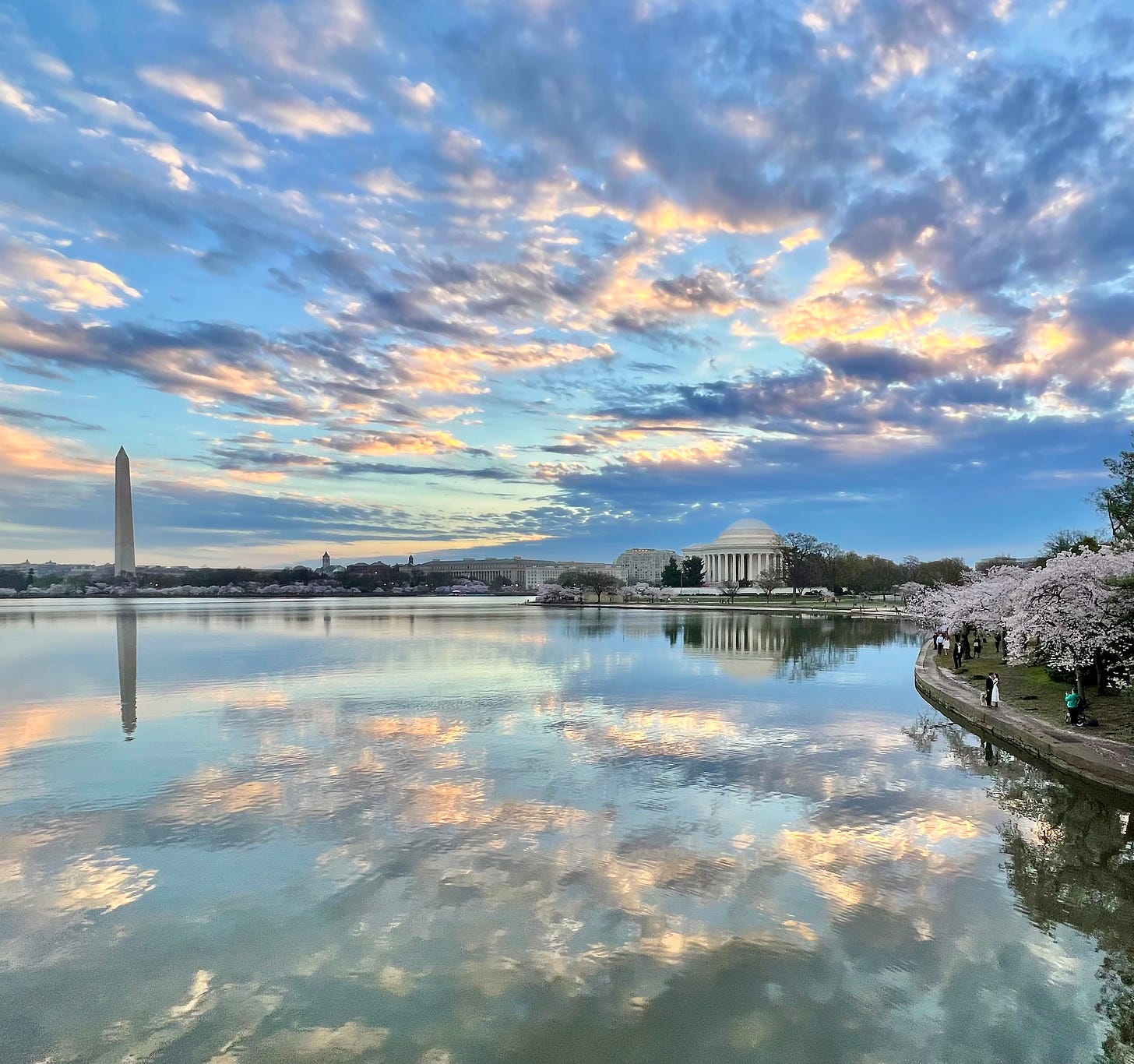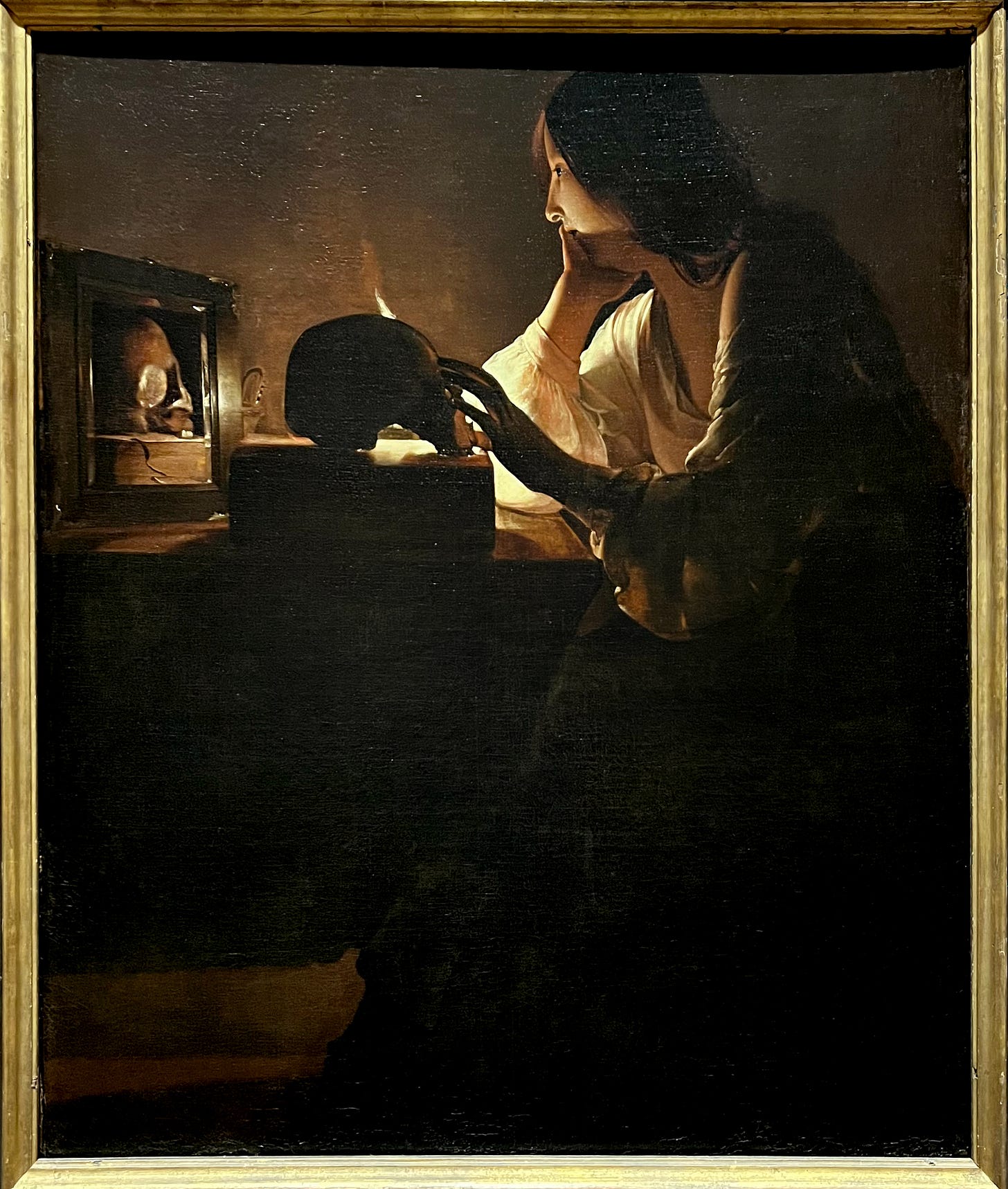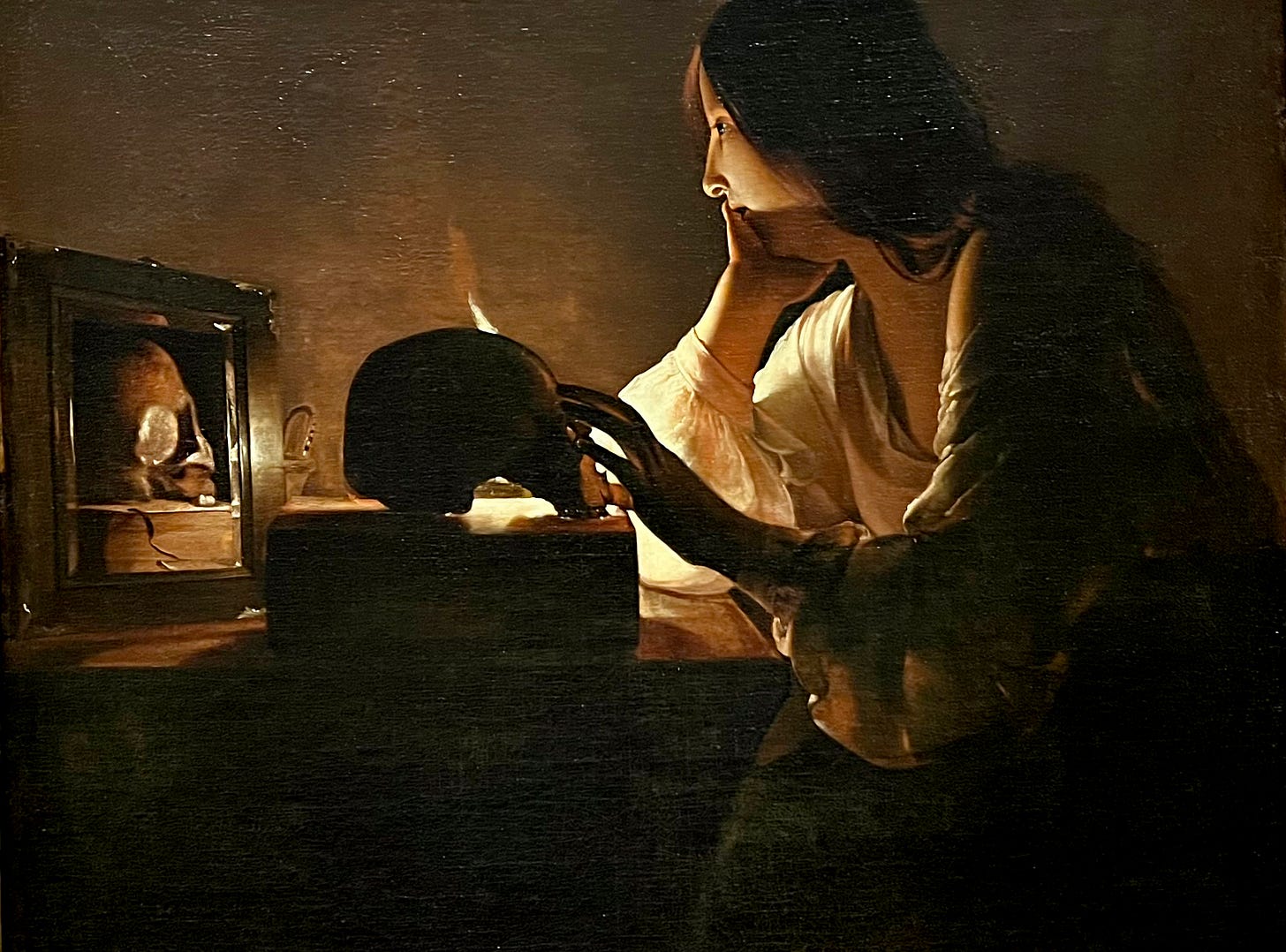De La Tour’s Repentant Magdalen and a Cherry Blossom Sunrise
On stillness and contemplation; a prayerful study of mirror reflections.
We can only really see ourselves by way of reflection in an effort to try to be objective.
Georges de La Tour’s “The Repentant Magdalen” (c.1635/1640) that hangs in room 37 of the National Gallery of Art in Washington, D.C., is an exquisite example of this contemplative exercise.
I recall the first time I saw a de La Tour Magdalen decades ago, (he has several) and I was overwhelmed by both its power (evoked by just using a single light from a candle) and its simplicity.
Simplicity and power are a brilliant combination in art, and prayer.
In the version we have at the NGA, (and my favorite!) what is so hauntingly beautiful is how Mary Magdalen gently rests her soft, young, and beautiful, glowing cheek on her hand, almost as though she is caressing it, while her other hand is resting tentatively on a hard, silhouetted skull nearby.
What is reflected in the mirror she is looking at, almost like an illusion of perspective from our vantage point, is not her beautiful face, but the deathly skull.
This entire quiet scene is illuminated by the light of a hidden candle suggested only by a flickering flame peeking above the skull.
The literal message can be understood as Mary Magdalen contemplating the fleeting vanities of life, as often portrayed allegorically by utilizing symbolic objects like mirrors and skulls.
The artist has cleverly included us in this composition by letting us think we can see ourselves as well in the reflection in the mirror, affording us an invitation to contemplate the natural end of our mortal life.
There are a few notable contexts to point out, like the use of light and darkness.
Almost the whole lower half of the painting is in darkness and visually suggests the weight of the subject being contemplated with its eternal consequences.
The light from the hidden candle can come to mean the light of Christ, and that only by seeking out His light, often obscured by false lights and vanities, can we rightly order all these things that can seem so confusing by the world’s standards.
I can also sense the tension between wanting to hold on to something and recognizing that in just a matter of time all is returned to dust.
The mirror’s reflection of the skull seems to indicate that Mary is already seeing her future self as the skull with her flesh and beauty gone, and asking the question, “What then remains?”
We can add our own questions:
What of me, when the fleeting beauties of this world, however objectively beautiful and good they may be, are consumed by time, sickness, or destruction… what remains? Have I prioritized well? Did I even know how to prioritize? What standard or ‘light’ did I use to make these evaluations?
This painting is such a good examination of conscience tool that can be used at any time, but especially during Holy Week.
The setting is simple, distraction free, with only a single source of input to measure by: the Christ light.
One can almost hear the flicker of the wick being consumed by a large flame, reminding us of how quickly time passes, and we too will be consumed. (If time had a sound, surely it would sound like a burning candle!)
When we are consummated and pass from this world, what are the things from our life that will be stored as treasures in heaven and remain immortal? How do I actively develop and store up virtues? When I’m gone, how might I leave a witness to the truth of Christ’s redeeming power? What will be my story to tell?
This imagery, whether de La Tour intended or not, to me allegorically points to “Christ our Light”, as intoned in the Easter Vigil procession with the Pascal Candle. It is the only light illuminating a church shrouded in darkness, signifying the Risen Savior, and that He is the only Light that truly helps us see and navigate in the world so often plagued by spiritual darkness. How diligent are we in seeking out His soft light and discerning it against so much false light pollution that can both distract and blind us?
Take a moment to put yourself in the scene and with one hand contemplate something you hold dear in this world and in the other, take that to its natural conclusion as represented by the skull. Let Christ show you how He sees the situation. What do you see reflected in the mirror? What are the gifts He has given you to nurture and share? What is His desire for you to take into eternity? How would that knowledge change the way you live now?
Let’s take a slight shift with another allegorical meditation to a brighter and grander scene lit by a single source, the sun.
It has been on my heart to compare these two images since I took an ordinary iPhone image of an extraordinary sunrise (pictured below) on the feast of the Annunciation, March 25th 2022. Given that almost a third of the iconic cherry blossom trees around The Tidal Basin in Washington, D.C. (to include all of the trees seen below on the right) are set for removal in order to repair a crumbling 100-year-old sea wall, it felt more poignant to reflect this image now.

The impending loss of these trees is something I’ve found myself grieving over for many reasons. I’ve spent the last 25 years visiting these blossoms in all their bud and bloom stages, so I know these trees very well. I’ve literally watched them grow and die. Under them I’ve picnicked, napped, read books, sketched, met interesting people… I’ve also done some of my most favorite portrait photography under these puffy white canopies as well. It's quite a spectacular and ethereal sight that I’ll write more about at another time. Suffice it to say for now, I’m at least grateful that this sudden news of the removal of my favorite groves of trees were at least timed during Lent so I can try to prayerfully keep all of God’s created beauty in perspective and reorient that longing towards a beauty that never fades.
Like in the de La Tour painting above, one of the things that makes this image so powerful is the reflection illuminated by a single light. Unlike the mirroring in the painting, the heavenly beauty of the sky is mirrored perfectly and produces a doubling/expanding effect, because of the still, calm waters. It is the stillness that I want to highlight here.
“Be still and know that I am God” Ps 46:10
As a photographer and artist, I’m always hoping for no wind, especially when shooting anything with water so that I can get these glorious mirror-like reflections.
There is an easy spiritual metaphor here, namely, that the more still and regulated in Christ we can maintain our spirit, the more in tune we are with God and can reflect His goodness like a mirror. The other Mary, the Mother of God is the exemplar of this mirroring. Again, how lovely that this image was taken on the feast of her ‘Yes’!
I am also a massive fan of scattered clouds during ‘golden hour’, the time that is just after and before a sunrise or sunset. The soft warm glow of an otherwise overpowering sun scatters around clouds from below and creates the most unique and unrepeatable color patterns in the sky. Pure, one-off gifts of God’s genius and creativity on display. Just because.
These one-of-a-kind sun-kissed cloud patterns are a natural reminder of each person’s uniqueness, and how we are all called to reflect in a way no one else can, something of the glory of God. When we learn to be still and anchored in Christ alone, we can mirror and expand His light more perfectly like Our Lady.
This is why greater self-knowledge and personal examinations about what kinds of things may be negatively stirring and making waves in our soul are so important.
It doesn’t take much, just someone to throw a pebble, or a small gust of wind in a still pond to create ripples and destroy the mirroring effect from the sun’s light on the water.
What might be some of the disruptions we experience through metaphorical pebbles thrown into our soul and scattering the mirror effect of the Son’s Light? Do we create these ripples ourselves? Do we seek them out unconsciously and habitually find ourselves in dysregulated and inflamed situations, feeling like we are just tossed about on waves? Do we fear the quiet of still waters? Perhaps afraid of what we might find there?
Our culture is so loud that it’s almost impossible to find complete silence anywhere and many people, especially the young, might find themselves bored if they even come close to that kind of stillness. It’s kind of ironic that I have found myself wearing earbuds just to create silence (even in a church!) so I can try to pray and listen to God’s still, small voice.
It can be a challenge, but it’s so important to carve out the quite spaces. God usually whispers to us; He does not shout if He speaks to our heart. How much silence do you think you are getting every day? If none, what are some creative ways you can carve out even 5 minutes of stillness and silence?
To conclude, these images of fleeting beauty can in some ways be hard to contemplate as they remind us that we cannot escape knowing that the material beauty of this world will decay and end. In other words, it’s a reminder of death that we cannot escape.
In these situations, it is always helpful to link these realizations to the events of Holy Week. When so much that seemed so good and hopeful for the disciples of Jesus suddenly turned horrific, and everything appeared lost, the Resurrection reminds us that purification through surrender is a form of death. It can be spiritual or physical, and both are necessary to enter into a redeemed state of right ordered eternal beauty that never fades.
Let’s end with a close-up view of Mary Magdalen’s contemplation with a deeper sense of quiet and stillness and invite Christ’s light to reveal one area that needs purification and redeeming within us now. What is He letting you see about yourself in the mirror? Ask Our Lady to help you see your potential in mirroring her Son.
Self-Reflection:
Did you notice anything sting or stir in your heart as you reflected on these images? Take note of the moment and context and try and write about it in your prayer journal to discover its roots and bring that to Confession if needed. See if anything points to potential obstacles or wounds that hinder you living out your life as God designed you to be, so that you are able to reflect back to yourself and to the world, some element of God’s glory, as only you can.
You might also like:
‘Pressing in’ on Good Friday
Grieving with the angels.
I was deeply moved by a small marble relief sculpture of the “Deposition” by Antonio d’Este, c1800, after a Canova model, that I saw at the Chicago Art Institute, and I had to make a drawing study* of a little detail so I could contemplate it more.
Thank you for reading and I hope it was edifying! To support more of this work, have a look at my SHOP and share my artwork created to help facilitate intimacy with Christ through beauty.
And don’t forget to subscribe, it’s FREE!
Photography and text by Renata Grzan Wieczorek. All Rights Reserved. Visit my About page for more information on usage.







